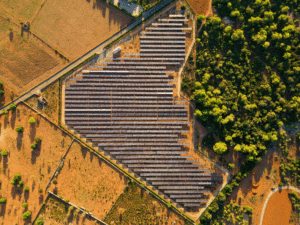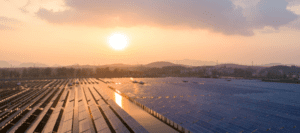Italy’s urgent push to scale up renewables deployment ahead of 2030 targets

Italy’s renewable energy story so far is a positive one and the sector is gaining momentum.
- In 2023, renewables generated 40% of Italy’s electricity, a major increase compared to a decade ago. Solar pv is at the forefront, with over 37GW installed, driven by large-scale projects in southern regions like Sicily and Lazio.
- Italy is a top European producer of biogas and biomethane. Thanks to a strong agricultural base, annual biomethane production exceeds 1.3 billion m³, contributing to both transport and residential heating. Wind energy continues to expand, including emerging offshore wind projects.
- The National Recovery and Resilience Plan (PNRR) is channeling substantial investments into clean energy technologies, especially solar, biogas, and green hydrogen. A key national goal is to install 5 GW of green hydrogen electrolyser capacity by 2030.
- Green hydrogen is attracting record investment, with sector revenues projected to grow over 40% annually. Major infrastructure projects aim to connect Italy’s hydrogen network with Austria, Germany, and North Africa, positioning the country as a key hub in Europe’s clean hydrogen future.
For the past decade, cleaner sources like solar and wind have bean steadily displacing coal use thanks to Italy’s climate and supportive policies.
Hydropower and especially natural gas remain part of the mix, and whilst cleaner than coal, Italy is working to reduce reliance on gas to meet climate goals.
The current state of renewables in Italy: sector breakdown
Italy is making the most of its warm climate, alpine geology and agriculture to harness its renewable resources.
Solar pv
Solar had a record year in 2024, with 6.8GW of new capacity installed— 30% over 2023—bringing the total to 37GW. Most of this growth came from large-scale projects, especially in sun-rich regions like Sicily and Lazio. Residential solar remains popular, though momentum is shifting toward commercial rooftops now that the “Superbonus” has ended. Italy is on track to reach 95GW by 2033.
Wind energy
Wind remains a key part of Italy’s energy mix at over 14GW of installed capacity. Most turbines are onshore in regions like Apulia, Campania, and Sicily, but attention is turning offshore. Floating wind projects, such as the 2.8 GW Med Wind in the Strait of Sicily, are gaining traction thanks to Italy’s deep coastal waters.
Hydropower
Hydropower still supplies about 14% of the country’s electricity, mainly from 4,860 plants in northern regions like Lombardy and Trentino-Alto Adige. While the sector is mature and growing slowly, it’s crucial for grid stability. Upcoming policy changes around expiring concessions could spark new investments and upgrades.
Biogas and biomethane
Italy is one of Europe’s top producers of biogas and biomethane, thanks to its strong agricultural sector. With 2GW of biogas capacity and 1.3 billion cubic meters of biomethane produced annually, the sector is growing steadily. Biomethane is becoming an increasingly attractive option for cleaner transport and heating, supported by incentives from the National Recovery and Resilience Plan.
Green hydrogen
Hydrogen is quickly becoming one of the most dynamic sectors. Italy plans to install 5GW of electrolyser capacity by 2030, with revenues expected to jump from $309 million in 2023 to over $3.4 billion. Projects from big energy companies are already underway, and plans for a hydrogen corridor connecting Italy to northern Europe and North Africa are taking shape.
Grid and Storage
As more renewables come online, energy storage is becoming essential. Italy is investing in large-scale batteries and pumped hydro to boost grid reliability. While it still lags behind leaders like Australia, progress is accelerating, backed by EU funding and national strategy.
Hurdles on the road to 2030
Ambitious plans face inevitable challenges related to technical, regulatory, economic, and social areas; Italy must address them swiftly and effectively to meet its 2030 goals. Transforming the energy sector to a low-carbon future is a generation-defining effort and the renewables industry has been addressing challenges like these for decades. Massive grid investments and new policies like RES-X auctions and fast-track permitting aim to speed things up.
- Permitting delays: Lengthy and complex approval processes often slow down renewables projects, especially wind and large solar installations. Despite general national support, local resistance due to visual, land use, or cultural concerns can delay projects.
- Grid infrastructure limitations: The power grid, especially in the south, needs upgrades to support more solar and wind capacity. Italy still lacks sufficient battery storage and smart grid tech to reliably balance growing renewable energy. Better cross-border grid connections are needed for Italy to become a renewable energy hub that’s Integrated with the broader EU energy market, especially for hydrogen transit.
- Uncertain policy and incentives: Changing policies and incentives, like the end of the “Superbonus,” create uncertainty that affects investment.
- Stable investment: around 2.5GW of utility-scale solar and wind capacity was connected to the grid in 2023 (from projects previously committed). But new financial commitments dropped from €5.8 billion in 2022 to just €1.4 billion and no new onshore wind projects reached financial close that year.
- Skilled workforce: The renewables sector is expanding faster than the supply of trained workers, requiring more training programs.
There are already signs that these issues are being addressed. For example, following the 2022 decline in wind investment, investment rebounded in 2024 with commitments for large-scale generation and storage reaching €8.7 billion — the highest since 2018.
The recovery suggests that policies such as the revised EU Renewable Energy Directive and updates to Italy’s Integrated National Energy and Climate Plan (PNIEC) are having a positive impact. Energy storage is attracting record levels of investment, with €4.8 billion committed in 2023 alone for large-scale battery projects, highlighting the growing need for grid-firming capacity in support of renewables.

Focusing on people to deliver Italy’s 2030 targets
At Taylor Hopkinson, our focus has always been on the crucial ‘people’ part of the energy transition.
Since our foundation in 2009, we’ve partnered with clients to tackle resource challenges as renewable energy technologies expand. The leadership roles needed to drive these projects require specialised skillsets that often don’t exist yet in newer markets. To fill these positions, we dive deep into our global network, seeking talent from countries further along in their renewable energy journeys who bring valuable hands-on experience.
-
View our latest renewables vacancies in Italy
-
Citations and sources
- Renewable sources covered a record 41% of Italy’s power demand | Enerdata
- Italy Natural Gas & Renewable Energy Market Report | 2033 – IMARC Group
- Italy’s Energy Strategy – Absolicon
- Italy’s climate action strategy – European Parliament PDF
- Italy – Countries & Regions – IEA
- Italy’s Renewable Market: Trends & Talent – WWR Energy
- Highest Annual Growth of Renewables Jobs in 2023, Reaching 16.2 Million – IRENA
- (PDF) The resistance to solar energy expansion in Italy: a systemic perspective
- Renewable energy sources: the conflict between environment and landscape from a planning perspective – CERIDAP
- Italy adds 6.8GW of PV in 2024 as utility-scale projects surge – PV Tech
- Italy installed 6.8 GW of solar in 2024 – PV Magazine
- In focus: Employment in EU’s renewable energy sector – European Commission
- Terna: electricity consumption increases by 2.2% in 2024
- Ministero dell’Ambiente e della Sicurezza Energetica (MASE)
- Piano Nazionale Integrato per l’Energia e il Clima (PNIEC)
- Gestore dei Servizi Energetici (GSE)
- Hydrogen Europe – Italy Projects
- IEEFA – Italy Energy Market Reports
- Terna 2019 Report

